Human Factors in Systems Design: MEDIGATE System Evaluation Report
VerifiedAdded on 2021/06/14
|17
|4952
|100
Report
AI Summary
This report presents a usability evaluation of the MEDIGATE system, an interactive system designed for healthcare professionals to manage patient information. The report details the system's purpose, which is to enhance the interaction between physicians and patients, and to facilitate the efficient recording of physical examination findings. It describes the target user population (physicians) and their assumed capabilities, emphasizing the need for medical knowledge to effectively utilize the system. The evaluation methodology employs the IMPACT model, focusing on user tasks, data collection through observation, questionnaires, and interviews. The report outlines the evaluation procedure, including task descriptions, debriefing questions, and performance analysis. The aim is to assess the system's effectiveness, efficiency, and user satisfaction, aiming to identify areas for improvement in the design and functionality of the MEDIGATE system. The evaluation includes pilot testing, user feedback, and both qualitative and quantitative data analysis to inform future system developments. The report concludes by highlighting the importance of incorporating user feedback to improve the system's usability and adaptability, ensuring it meets the needs of healthcare professionals and enhances patient care.

HUMAN FACTORS IN SYSTEMS DESIGN
By
(Name)
(Course)
(Professor’s Name)
(Institution)
(State)
(Date)
By
(Name)
(Course)
(Professor’s Name)
(Institution)
(State)
(Date)
Paraphrase This Document
Need a fresh take? Get an instant paraphrase of this document with our AI Paraphraser
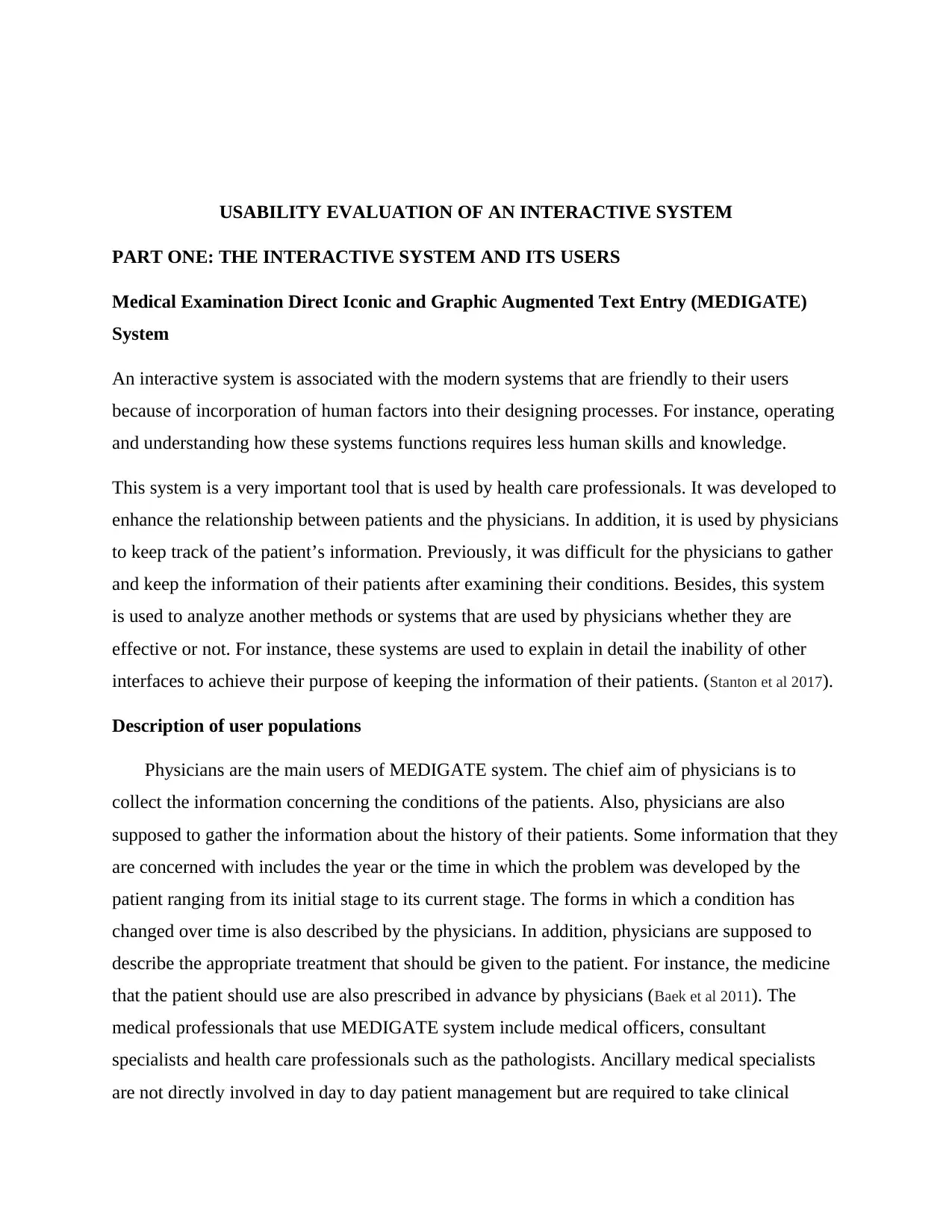
USABILITY EVALUATION OF AN INTERACTIVE SYSTEM
PART ONE: THE INTERACTIVE SYSTEM AND ITS USERS
Medical Examination Direct Iconic and Graphic Augmented Text Entry (MEDIGATE)
System
An interactive system is associated with the modern systems that are friendly to their users
because of incorporation of human factors into their designing processes. For instance, operating
and understanding how these systems functions requires less human skills and knowledge.
This system is a very important tool that is used by health care professionals. It was developed to
enhance the relationship between patients and the physicians. In addition, it is used by physicians
to keep track of the patient’s information. Previously, it was difficult for the physicians to gather
and keep the information of their patients after examining their conditions. Besides, this system
is used to analyze another methods or systems that are used by physicians whether they are
effective or not. For instance, these systems are used to explain in detail the inability of other
interfaces to achieve their purpose of keeping the information of their patients. (Stanton et al 2017).
Description of user populations
Physicians are the main users of MEDIGATE system. The chief aim of physicians is to
collect the information concerning the conditions of the patients. Also, physicians are also
supposed to gather the information about the history of their patients. Some information that they
are concerned with includes the year or the time in which the problem was developed by the
patient ranging from its initial stage to its current stage. The forms in which a condition has
changed over time is also described by the physicians. In addition, physicians are supposed to
describe the appropriate treatment that should be given to the patient. For instance, the medicine
that the patient should use are also prescribed in advance by physicians (Baek et al 2011). The
medical professionals that use MEDIGATE system include medical officers, consultant
specialists and health care professionals such as the pathologists. Ancillary medical specialists
are not directly involved in day to day patient management but are required to take clinical
PART ONE: THE INTERACTIVE SYSTEM AND ITS USERS
Medical Examination Direct Iconic and Graphic Augmented Text Entry (MEDIGATE)
System
An interactive system is associated with the modern systems that are friendly to their users
because of incorporation of human factors into their designing processes. For instance, operating
and understanding how these systems functions requires less human skills and knowledge.
This system is a very important tool that is used by health care professionals. It was developed to
enhance the relationship between patients and the physicians. In addition, it is used by physicians
to keep track of the patient’s information. Previously, it was difficult for the physicians to gather
and keep the information of their patients after examining their conditions. Besides, this system
is used to analyze another methods or systems that are used by physicians whether they are
effective or not. For instance, these systems are used to explain in detail the inability of other
interfaces to achieve their purpose of keeping the information of their patients. (Stanton et al 2017).
Description of user populations
Physicians are the main users of MEDIGATE system. The chief aim of physicians is to
collect the information concerning the conditions of the patients. Also, physicians are also
supposed to gather the information about the history of their patients. Some information that they
are concerned with includes the year or the time in which the problem was developed by the
patient ranging from its initial stage to its current stage. The forms in which a condition has
changed over time is also described by the physicians. In addition, physicians are supposed to
describe the appropriate treatment that should be given to the patient. For instance, the medicine
that the patient should use are also prescribed in advance by physicians (Baek et al 2011). The
medical professionals that use MEDIGATE system include medical officers, consultant
specialists and health care professionals such as the pathologists. Ancillary medical specialists
are not directly involved in day to day patient management but are required to take clinical
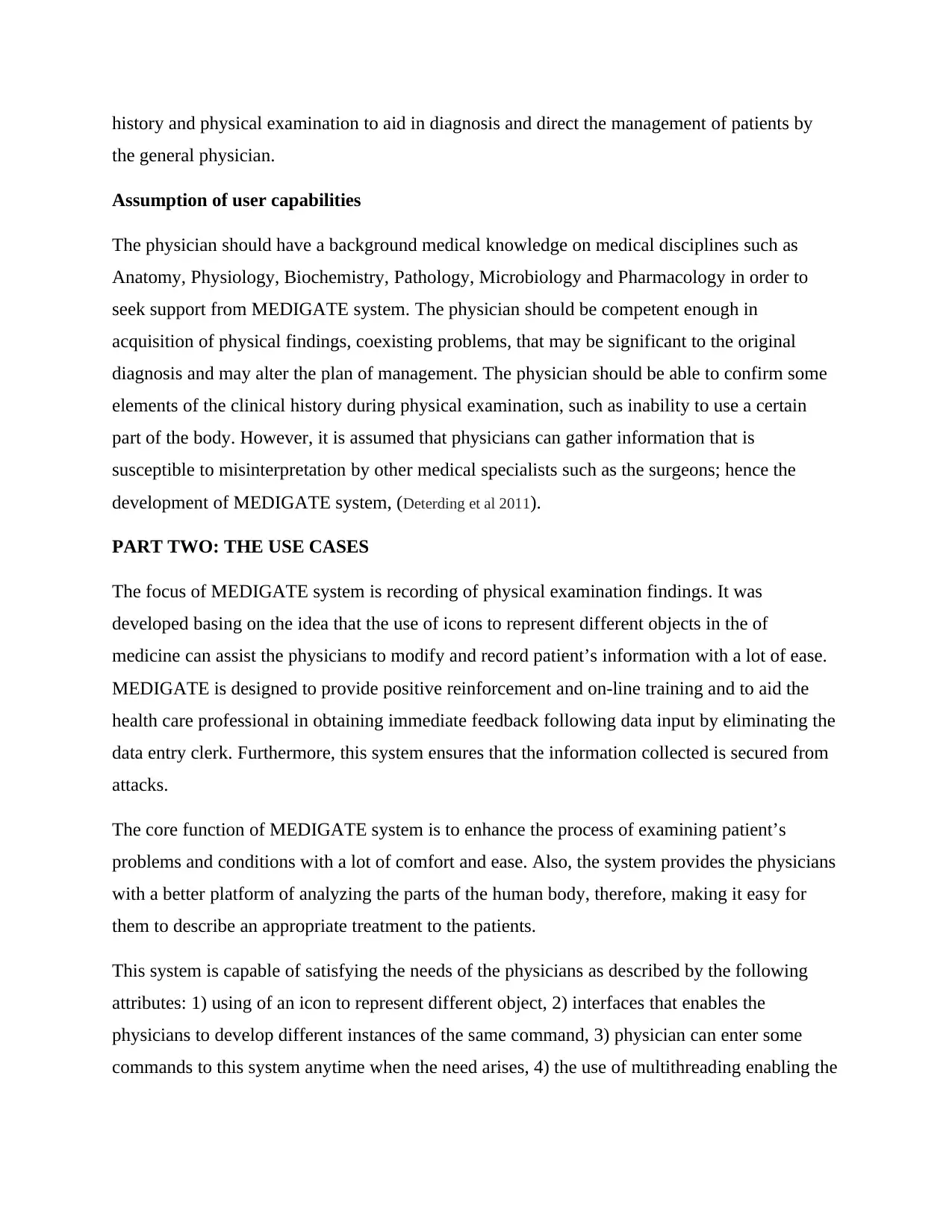
history and physical examination to aid in diagnosis and direct the management of patients by
the general physician.
Assumption of user capabilities
The physician should have a background medical knowledge on medical disciplines such as
Anatomy, Physiology, Biochemistry, Pathology, Microbiology and Pharmacology in order to
seek support from MEDIGATE system. The physician should be competent enough in
acquisition of physical findings, coexisting problems, that may be significant to the original
diagnosis and may alter the plan of management. The physician should be able to confirm some
elements of the clinical history during physical examination, such as inability to use a certain
part of the body. However, it is assumed that physicians can gather information that is
susceptible to misinterpretation by other medical specialists such as the surgeons; hence the
development of MEDIGATE system, (Deterding et al 2011).
PART TWO: THE USE CASES
The focus of MEDIGATE system is recording of physical examination findings. It was
developed basing on the idea that the use of icons to represent different objects in the of
medicine can assist the physicians to modify and record patient’s information with a lot of ease.
MEDIGATE is designed to provide positive reinforcement and on-line training and to aid the
health care professional in obtaining immediate feedback following data input by eliminating the
data entry clerk. Furthermore, this system ensures that the information collected is secured from
attacks.
The core function of MEDIGATE system is to enhance the process of examining patient’s
problems and conditions with a lot of comfort and ease. Also, the system provides the physicians
with a better platform of analyzing the parts of the human body, therefore, making it easy for
them to describe an appropriate treatment to the patients.
This system is capable of satisfying the needs of the physicians as described by the following
attributes: 1) using of an icon to represent different object, 2) interfaces that enables the
physicians to develop different instances of the same command, 3) physician can enter some
commands to this system anytime when the need arises, 4) the use of multithreading enabling the
the general physician.
Assumption of user capabilities
The physician should have a background medical knowledge on medical disciplines such as
Anatomy, Physiology, Biochemistry, Pathology, Microbiology and Pharmacology in order to
seek support from MEDIGATE system. The physician should be competent enough in
acquisition of physical findings, coexisting problems, that may be significant to the original
diagnosis and may alter the plan of management. The physician should be able to confirm some
elements of the clinical history during physical examination, such as inability to use a certain
part of the body. However, it is assumed that physicians can gather information that is
susceptible to misinterpretation by other medical specialists such as the surgeons; hence the
development of MEDIGATE system, (Deterding et al 2011).
PART TWO: THE USE CASES
The focus of MEDIGATE system is recording of physical examination findings. It was
developed basing on the idea that the use of icons to represent different objects in the of
medicine can assist the physicians to modify and record patient’s information with a lot of ease.
MEDIGATE is designed to provide positive reinforcement and on-line training and to aid the
health care professional in obtaining immediate feedback following data input by eliminating the
data entry clerk. Furthermore, this system ensures that the information collected is secured from
attacks.
The core function of MEDIGATE system is to enhance the process of examining patient’s
problems and conditions with a lot of comfort and ease. Also, the system provides the physicians
with a better platform of analyzing the parts of the human body, therefore, making it easy for
them to describe an appropriate treatment to the patients.
This system is capable of satisfying the needs of the physicians as described by the following
attributes: 1) using of an icon to represent different object, 2) interfaces that enables the
physicians to develop different instances of the same command, 3) physician can enter some
commands to this system anytime when the need arises, 4) the use of multithreading enabling the
⊘ This is a preview!⊘
Do you want full access?
Subscribe today to unlock all pages.

Trusted by 1+ million students worldwide
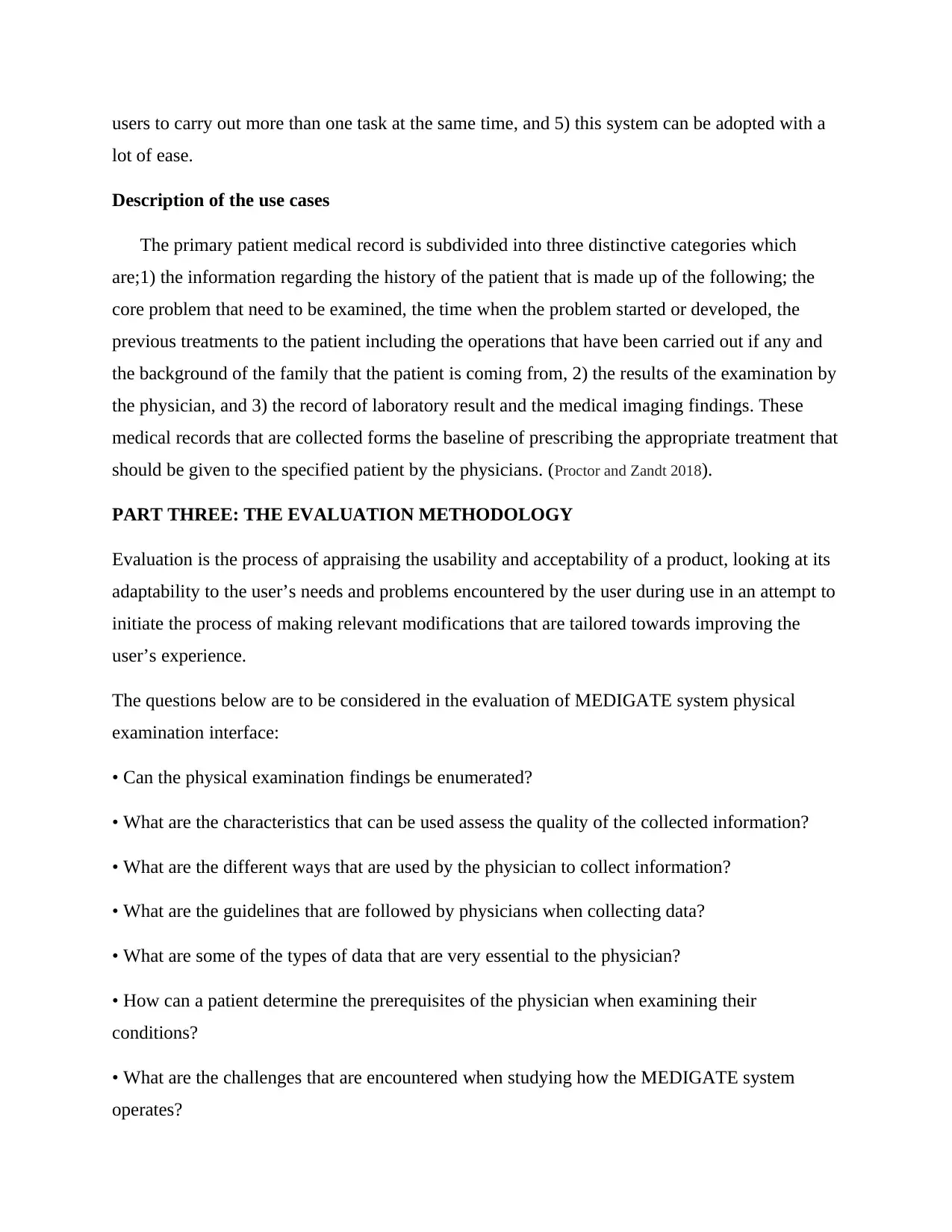
users to carry out more than one task at the same time, and 5) this system can be adopted with a
lot of ease.
Description of the use cases
The primary patient medical record is subdivided into three distinctive categories which
are;1) the information regarding the history of the patient that is made up of the following; the
core problem that need to be examined, the time when the problem started or developed, the
previous treatments to the patient including the operations that have been carried out if any and
the background of the family that the patient is coming from, 2) the results of the examination by
the physician, and 3) the record of laboratory result and the medical imaging findings. These
medical records that are collected forms the baseline of prescribing the appropriate treatment that
should be given to the specified patient by the physicians. (Proctor and Zandt 2018).
PART THREE: THE EVALUATION METHODOLOGY
Evaluation is the process of appraising the usability and acceptability of a product, looking at its
adaptability to the user’s needs and problems encountered by the user during use in an attempt to
initiate the process of making relevant modifications that are tailored towards improving the
user’s experience.
The questions below are to be considered in the evaluation of MEDIGATE system physical
examination interface:
• Can the physical examination findings be enumerated?
• What are the characteristics that can be used assess the quality of the collected information?
• What are the different ways that are used by the physician to collect information?
• What are the guidelines that are followed by physicians when collecting data?
• What are some of the types of data that are very essential to the physician?
• How can a patient determine the prerequisites of the physician when examining their
conditions?
• What are the challenges that are encountered when studying how the MEDIGATE system
operates?
lot of ease.
Description of the use cases
The primary patient medical record is subdivided into three distinctive categories which
are;1) the information regarding the history of the patient that is made up of the following; the
core problem that need to be examined, the time when the problem started or developed, the
previous treatments to the patient including the operations that have been carried out if any and
the background of the family that the patient is coming from, 2) the results of the examination by
the physician, and 3) the record of laboratory result and the medical imaging findings. These
medical records that are collected forms the baseline of prescribing the appropriate treatment that
should be given to the specified patient by the physicians. (Proctor and Zandt 2018).
PART THREE: THE EVALUATION METHODOLOGY
Evaluation is the process of appraising the usability and acceptability of a product, looking at its
adaptability to the user’s needs and problems encountered by the user during use in an attempt to
initiate the process of making relevant modifications that are tailored towards improving the
user’s experience.
The questions below are to be considered in the evaluation of MEDIGATE system physical
examination interface:
• Can the physical examination findings be enumerated?
• What are the characteristics that can be used assess the quality of the collected information?
• What are the different ways that are used by the physician to collect information?
• What are the guidelines that are followed by physicians when collecting data?
• What are some of the types of data that are very essential to the physician?
• How can a patient determine the prerequisites of the physician when examining their
conditions?
• What are the challenges that are encountered when studying how the MEDIGATE system
operates?
Paraphrase This Document
Need a fresh take? Get an instant paraphrase of this document with our AI Paraphraser
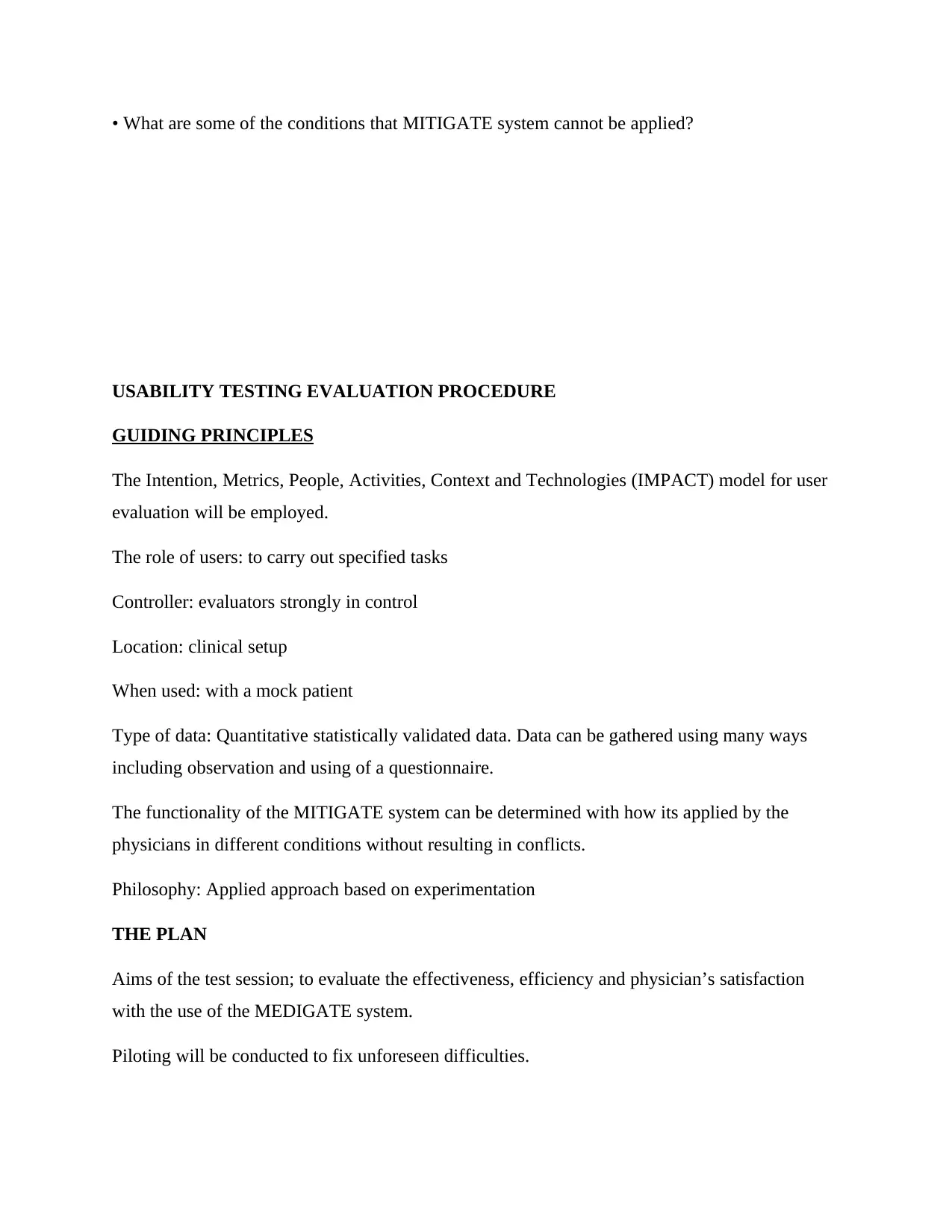
• What are some of the conditions that MITIGATE system cannot be applied?
USABILITY TESTING EVALUATION PROCEDURE
GUIDING PRINCIPLES
The Intention, Metrics, People, Activities, Context and Technologies (IMPACT) model for user
evaluation will be employed.
The role of users: to carry out specified tasks
Controller: evaluators strongly in control
Location: clinical setup
When used: with a mock patient
Type of data: Quantitative statistically validated data. Data can be gathered using many ways
including observation and using of a questionnaire.
The functionality of the MITIGATE system can be determined with how its applied by the
physicians in different conditions without resulting in conflicts.
Philosophy: Applied approach based on experimentation
THE PLAN
Aims of the test session; to evaluate the effectiveness, efficiency and physician’s satisfaction
with the use of the MEDIGATE system.
Piloting will be conducted to fix unforeseen difficulties.
USABILITY TESTING EVALUATION PROCEDURE
GUIDING PRINCIPLES
The Intention, Metrics, People, Activities, Context and Technologies (IMPACT) model for user
evaluation will be employed.
The role of users: to carry out specified tasks
Controller: evaluators strongly in control
Location: clinical setup
When used: with a mock patient
Type of data: Quantitative statistically validated data. Data can be gathered using many ways
including observation and using of a questionnaire.
The functionality of the MITIGATE system can be determined with how its applied by the
physicians in different conditions without resulting in conflicts.
Philosophy: Applied approach based on experimentation
THE PLAN
Aims of the test session; to evaluate the effectiveness, efficiency and physician’s satisfaction
with the use of the MEDIGATE system.
Piloting will be conducted to fix unforeseen difficulties.

The evaluation will be conducted using a patient, for at most fifteen minutes. MEDIGATE
system will be used and data collected by audio recording, questionnaires and interviews.
Numbers and types of user: 5 physicians and at least one ancillary consultant per specialty.
Tasks to be performed with successful completion highlighted by arriving at top differential
diagnoses. Both qualitative and quantitative data to be collected and analyzed using Microsoft
Excel.
EVALUATION PROCEDURE
1. The initial step of evaluating the system is marked the following processes; determining
the goals that the system is set to achieve, identifying the users of the system and the
description of the environment that the system will be used such as the field of medicine
among others.
2. Identify the guidelines under which the system will be evaluated.
3. Re-visit the ideas of the system developer.
4. Prepare users for testing the system basing on the requirements of the system.
5. Select the users that will meet certain criterion that has been specified along with
determination of the place of testing the system.
6. Pilot the evaluation to fix unforeseen errors
7. Examine the functioning of the system.
USER TASKS
The physician will be expected to evaluate the MEDIGATE System by examining the abdomen
based on: comfort of using the system, capability of the system to achieve its core purpose and
the problems that are associated when using the system.
TASK DESCRIPTION
Clarity of MEDIGATE system.
The functionality of the system.
system will be used and data collected by audio recording, questionnaires and interviews.
Numbers and types of user: 5 physicians and at least one ancillary consultant per specialty.
Tasks to be performed with successful completion highlighted by arriving at top differential
diagnoses. Both qualitative and quantitative data to be collected and analyzed using Microsoft
Excel.
EVALUATION PROCEDURE
1. The initial step of evaluating the system is marked the following processes; determining
the goals that the system is set to achieve, identifying the users of the system and the
description of the environment that the system will be used such as the field of medicine
among others.
2. Identify the guidelines under which the system will be evaluated.
3. Re-visit the ideas of the system developer.
4. Prepare users for testing the system basing on the requirements of the system.
5. Select the users that will meet certain criterion that has been specified along with
determination of the place of testing the system.
6. Pilot the evaluation to fix unforeseen errors
7. Examine the functioning of the system.
USER TASKS
The physician will be expected to evaluate the MEDIGATE System by examining the abdomen
based on: comfort of using the system, capability of the system to achieve its core purpose and
the problems that are associated when using the system.
TASK DESCRIPTION
Clarity of MEDIGATE system.
The functionality of the system.
⊘ This is a preview!⊘
Do you want full access?
Subscribe today to unlock all pages.

Trusted by 1+ million students worldwide
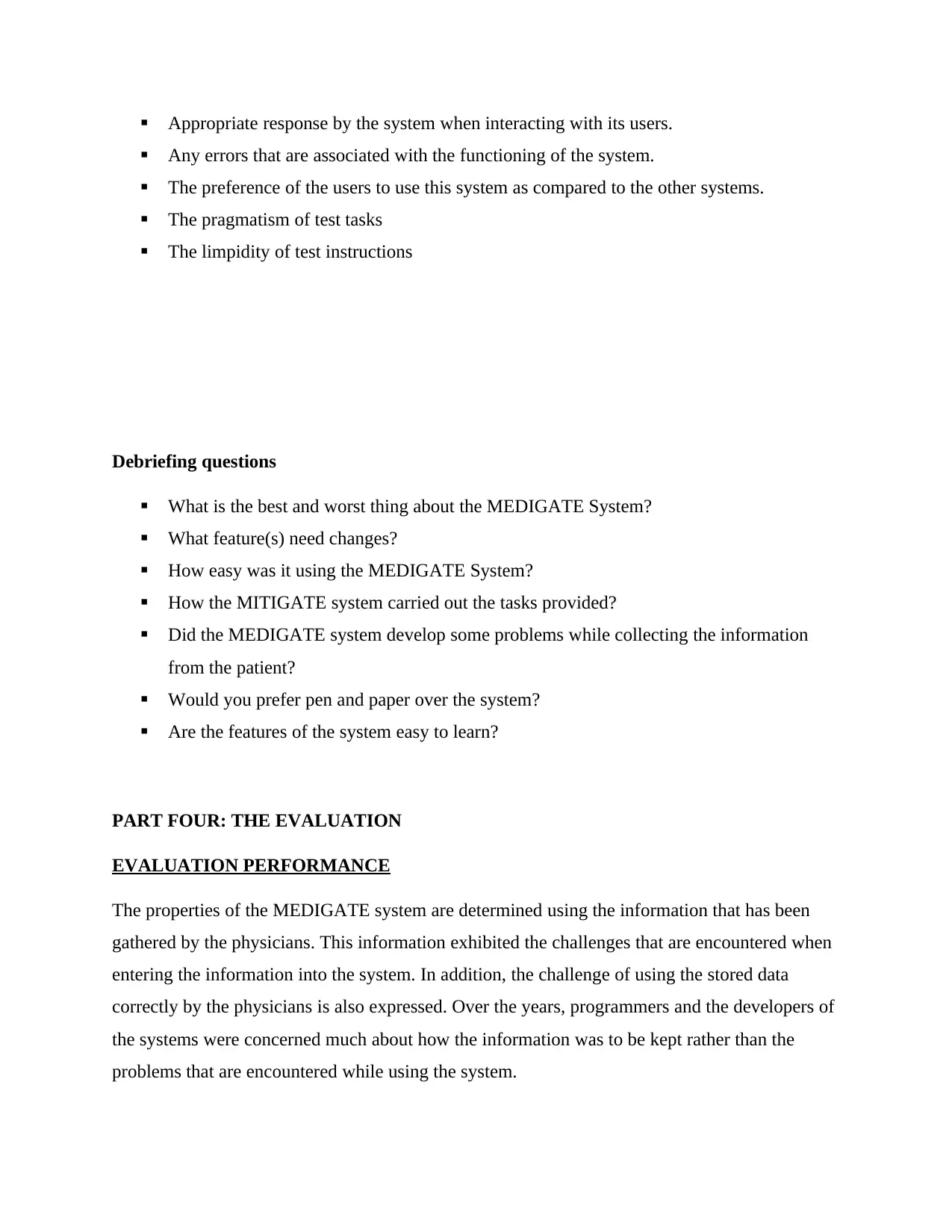
Appropriate response by the system when interacting with its users.
Any errors that are associated with the functioning of the system.
The preference of the users to use this system as compared to the other systems.
The pragmatism of test tasks
The limpidity of test instructions
Debriefing questions
What is the best and worst thing about the MEDIGATE System?
What feature(s) need changes?
How easy was it using the MEDIGATE System?
How the MITIGATE system carried out the tasks provided?
Did the MEDIGATE system develop some problems while collecting the information
from the patient?
Would you prefer pen and paper over the system?
Are the features of the system easy to learn?
PART FOUR: THE EVALUATION
EVALUATION PERFORMANCE
The properties of the MEDIGATE system are determined using the information that has been
gathered by the physicians. This information exhibited the challenges that are encountered when
entering the information into the system. In addition, the challenge of using the stored data
correctly by the physicians is also expressed. Over the years, programmers and the developers of
the systems were concerned much about how the information was to be kept rather than the
problems that are encountered while using the system.
Any errors that are associated with the functioning of the system.
The preference of the users to use this system as compared to the other systems.
The pragmatism of test tasks
The limpidity of test instructions
Debriefing questions
What is the best and worst thing about the MEDIGATE System?
What feature(s) need changes?
How easy was it using the MEDIGATE System?
How the MITIGATE system carried out the tasks provided?
Did the MEDIGATE system develop some problems while collecting the information
from the patient?
Would you prefer pen and paper over the system?
Are the features of the system easy to learn?
PART FOUR: THE EVALUATION
EVALUATION PERFORMANCE
The properties of the MEDIGATE system are determined using the information that has been
gathered by the physicians. This information exhibited the challenges that are encountered when
entering the information into the system. In addition, the challenge of using the stored data
correctly by the physicians is also expressed. Over the years, programmers and the developers of
the systems were concerned much about how the information was to be kept rather than the
problems that are encountered while using the system.
Paraphrase This Document
Need a fresh take? Get an instant paraphrase of this document with our AI Paraphraser

Developing a better computer system requires the need of correcting all the errors and problems
that are encountered while using the system. Also, incorporating of all the prerequisites that have
been specified by the system users is also very crucial. The proposed system must be able to
satisfy the needs of its users.
The programmers and developers have developed the MITIGATE system basing on all the
necessities that are required when developing and designing modern computer systems. This
system has been developed using icons whereby different icons are used to represent different
objects.
The principles underlying the process of designing the MEDIGATE System can be incorporated
in any upcoming systems that uses the voice identification techniques. Also, they can be
incorporated in the systems that uses pens as one of the tools. Therefore, this can enhance the
ease of adopting and using the system. MEDIGATE system can be applied in many digital
systems enabling them to achieve their purpose and functions.
THE EVALUATION PROCEDURE
1. Write a draft list of tasks using scenarios prepared earlier. These must be the actual tasks
that can be completed successfully by the MITIGATE system. The tasks must also be
able to test all the functioning of the system.
2. Test the specific functions of the system and approximate the period that the users can
take to finish a certain task using the system.
3. Create a list of tasks that should be completed by the physicians. Describe the tasks
clearly in such a way that the newbie can comprehend how the tasks are to be performed.
4. Get ready for the test session. Have the MEDIGATE system ready in a suitable
environment and list of prompt questions, notebook and pens ready, and an audio
recorder.
5. Inform the users that the system is under the trial process and has not yet been
implemented. Define clearly how the tasks should be done. Physicians should not work
as a group for ease of monitoring. Start recording if an audio recorder has already been
set in place.
that are encountered while using the system. Also, incorporating of all the prerequisites that have
been specified by the system users is also very crucial. The proposed system must be able to
satisfy the needs of its users.
The programmers and developers have developed the MITIGATE system basing on all the
necessities that are required when developing and designing modern computer systems. This
system has been developed using icons whereby different icons are used to represent different
objects.
The principles underlying the process of designing the MEDIGATE System can be incorporated
in any upcoming systems that uses the voice identification techniques. Also, they can be
incorporated in the systems that uses pens as one of the tools. Therefore, this can enhance the
ease of adopting and using the system. MEDIGATE system can be applied in many digital
systems enabling them to achieve their purpose and functions.
THE EVALUATION PROCEDURE
1. Write a draft list of tasks using scenarios prepared earlier. These must be the actual tasks
that can be completed successfully by the MITIGATE system. The tasks must also be
able to test all the functioning of the system.
2. Test the specific functions of the system and approximate the period that the users can
take to finish a certain task using the system.
3. Create a list of tasks that should be completed by the physicians. Describe the tasks
clearly in such a way that the newbie can comprehend how the tasks are to be performed.
4. Get ready for the test session. Have the MEDIGATE system ready in a suitable
environment and list of prompt questions, notebook and pens ready, and an audio
recorder.
5. Inform the users that the system is under the trial process and has not yet been
implemented. Define clearly how the tasks should be done. Physicians should not work
as a group for ease of monitoring. Start recording if an audio recorder has already been
set in place.
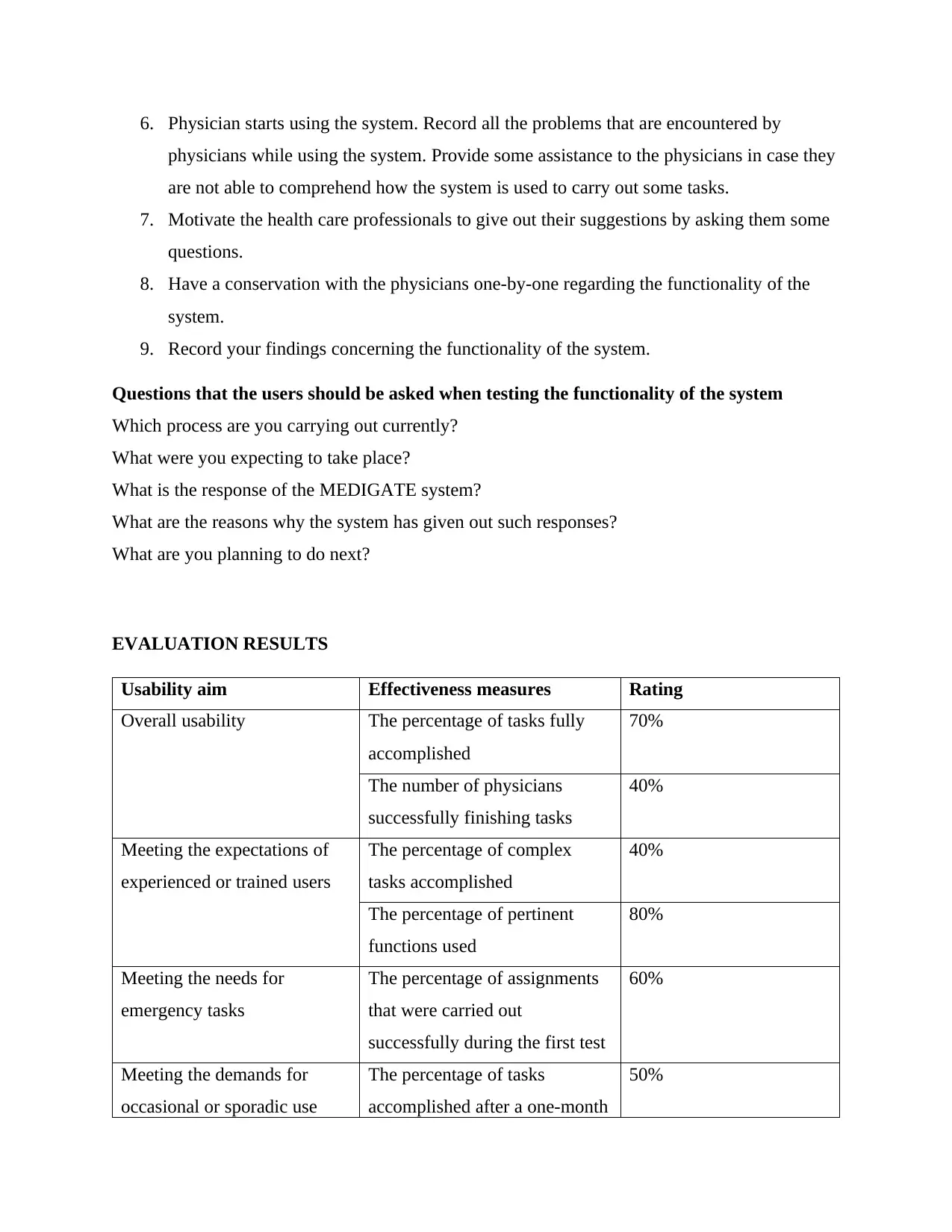
6. Physician starts using the system. Record all the problems that are encountered by
physicians while using the system. Provide some assistance to the physicians in case they
are not able to comprehend how the system is used to carry out some tasks.
7. Motivate the health care professionals to give out their suggestions by asking them some
questions.
8. Have a conservation with the physicians one-by-one regarding the functionality of the
system.
9. Record your findings concerning the functionality of the system.
Questions that the users should be asked when testing the functionality of the system
Which process are you carrying out currently?
What were you expecting to take place?
What is the response of the MEDIGATE system?
What are the reasons why the system has given out such responses?
What are you planning to do next?
EVALUATION RESULTS
Usability aim Effectiveness measures Rating
Overall usability The percentage of tasks fully
accomplished
70%
The number of physicians
successfully finishing tasks
40%
Meeting the expectations of
experienced or trained users
The percentage of complex
tasks accomplished
40%
The percentage of pertinent
functions used
80%
Meeting the needs for
emergency tasks
The percentage of assignments
that were carried out
successfully during the first test
60%
Meeting the demands for
occasional or sporadic use
The percentage of tasks
accomplished after a one-month
50%
physicians while using the system. Provide some assistance to the physicians in case they
are not able to comprehend how the system is used to carry out some tasks.
7. Motivate the health care professionals to give out their suggestions by asking them some
questions.
8. Have a conservation with the physicians one-by-one regarding the functionality of the
system.
9. Record your findings concerning the functionality of the system.
Questions that the users should be asked when testing the functionality of the system
Which process are you carrying out currently?
What were you expecting to take place?
What is the response of the MEDIGATE system?
What are the reasons why the system has given out such responses?
What are you planning to do next?
EVALUATION RESULTS
Usability aim Effectiveness measures Rating
Overall usability The percentage of tasks fully
accomplished
70%
The number of physicians
successfully finishing tasks
40%
Meeting the expectations of
experienced or trained users
The percentage of complex
tasks accomplished
40%
The percentage of pertinent
functions used
80%
Meeting the needs for
emergency tasks
The percentage of assignments
that were carried out
successfully during the first test
60%
Meeting the demands for
occasional or sporadic use
The percentage of tasks
accomplished after a one-month
50%
⊘ This is a preview!⊘
Do you want full access?
Subscribe today to unlock all pages.

Trusted by 1+ million students worldwide
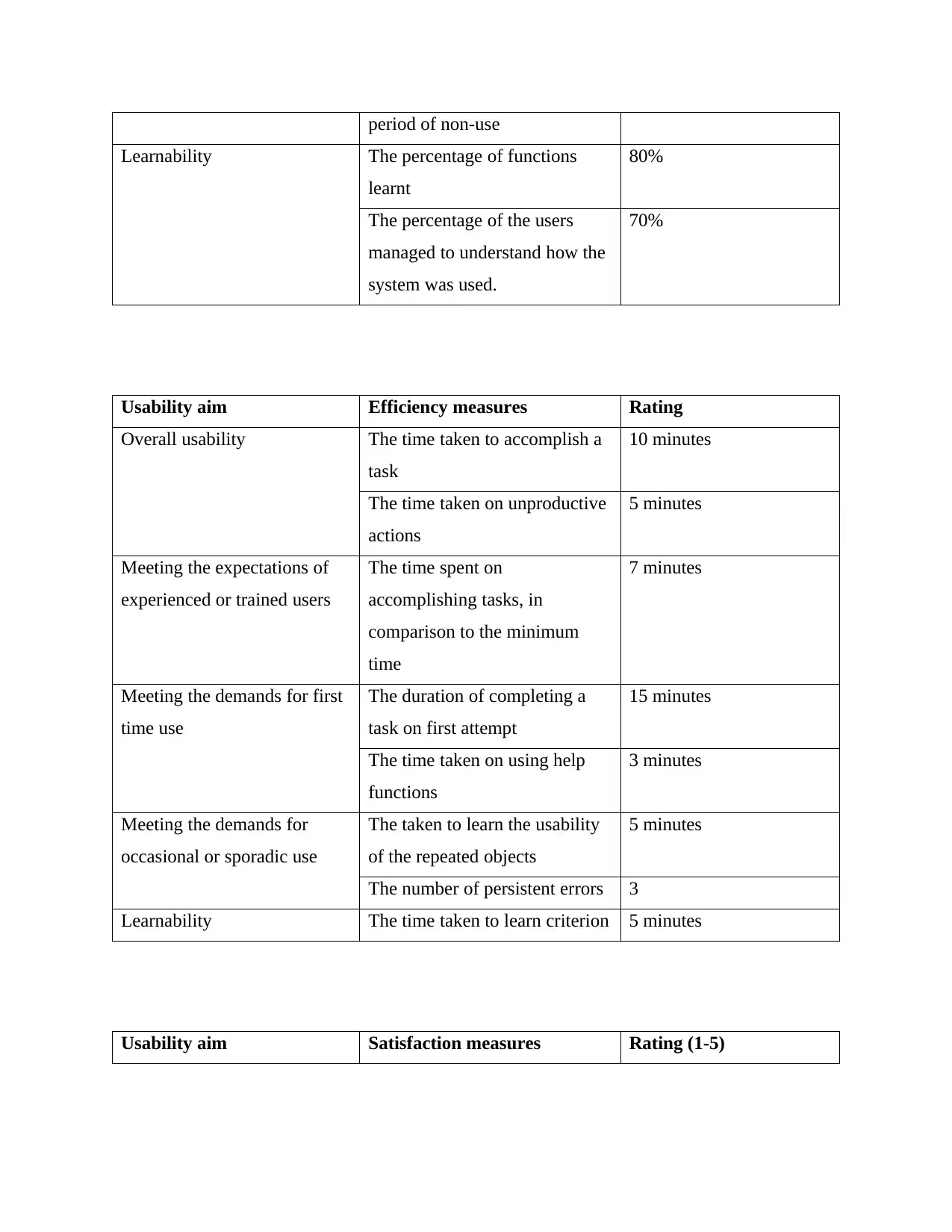
period of non-use
Learnability The percentage of functions
learnt
80%
The percentage of the users
managed to understand how the
system was used.
70%
Usability aim Efficiency measures Rating
Overall usability The time taken to accomplish a
task
10 minutes
The time taken on unproductive
actions
5 minutes
Meeting the expectations of
experienced or trained users
The time spent on
accomplishing tasks, in
comparison to the minimum
time
7 minutes
Meeting the demands for first
time use
The duration of completing a
task on first attempt
15 minutes
The time taken on using help
functions
3 minutes
Meeting the demands for
occasional or sporadic use
The taken to learn the usability
of the repeated objects
5 minutes
The number of persistent errors 3
Learnability The time taken to learn criterion 5 minutes
Usability aim Satisfaction measures Rating (1-5)
Learnability The percentage of functions
learnt
80%
The percentage of the users
managed to understand how the
system was used.
70%
Usability aim Efficiency measures Rating
Overall usability The time taken to accomplish a
task
10 minutes
The time taken on unproductive
actions
5 minutes
Meeting the expectations of
experienced or trained users
The time spent on
accomplishing tasks, in
comparison to the minimum
time
7 minutes
Meeting the demands for first
time use
The duration of completing a
task on first attempt
15 minutes
The time taken on using help
functions
3 minutes
Meeting the demands for
occasional or sporadic use
The taken to learn the usability
of the repeated objects
5 minutes
The number of persistent errors 3
Learnability The time taken to learn criterion 5 minutes
Usability aim Satisfaction measures Rating (1-5)
Paraphrase This Document
Need a fresh take? Get an instant paraphrase of this document with our AI Paraphraser
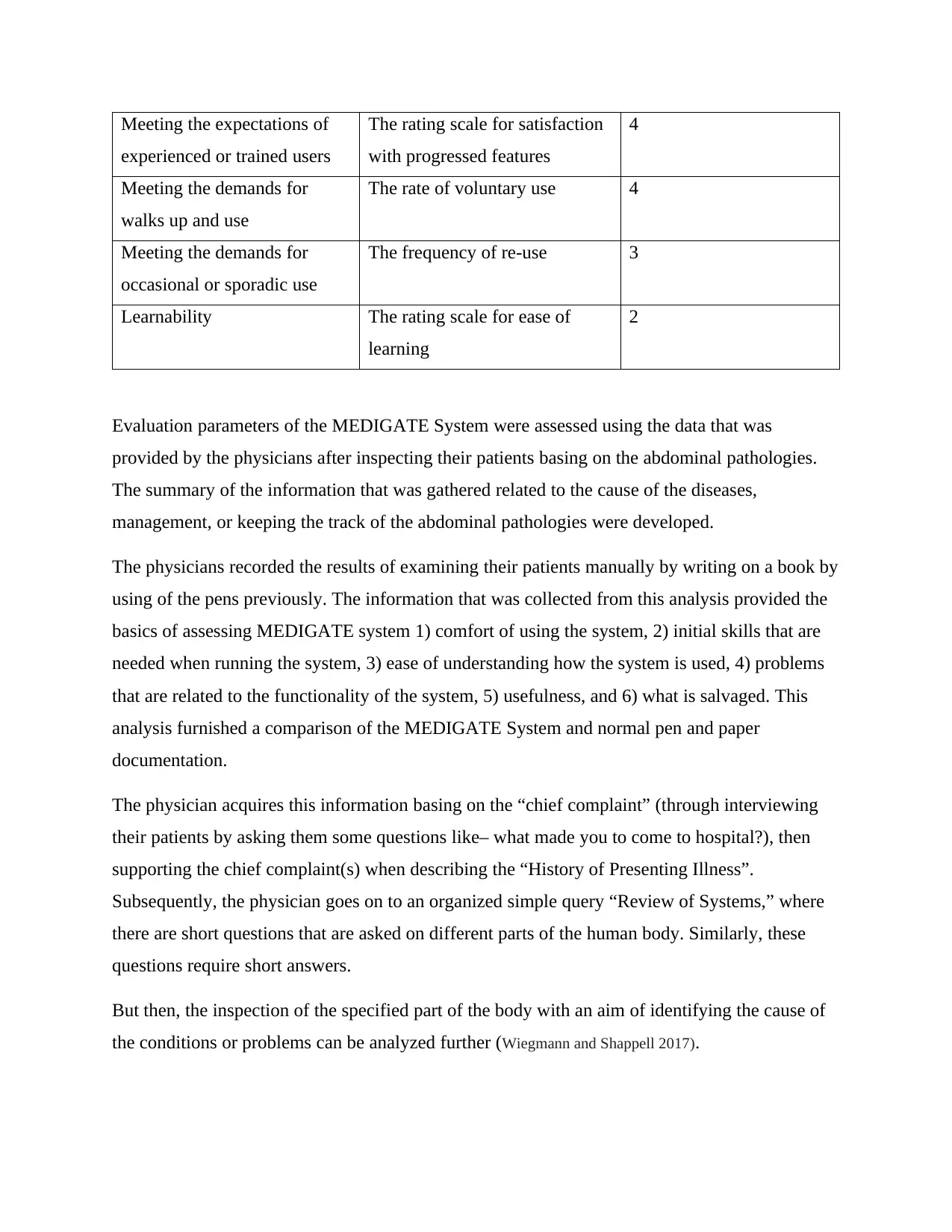
Meeting the expectations of
experienced or trained users
The rating scale for satisfaction
with progressed features
4
Meeting the demands for
walks up and use
The rate of voluntary use 4
Meeting the demands for
occasional or sporadic use
The frequency of re-use 3
Learnability The rating scale for ease of
learning
2
Evaluation parameters of the MEDIGATE System were assessed using the data that was
provided by the physicians after inspecting their patients basing on the abdominal pathologies.
The summary of the information that was gathered related to the cause of the diseases,
management, or keeping the track of the abdominal pathologies were developed.
The physicians recorded the results of examining their patients manually by writing on a book by
using of the pens previously. The information that was collected from this analysis provided the
basics of assessing MEDIGATE system 1) comfort of using the system, 2) initial skills that are
needed when running the system, 3) ease of understanding how the system is used, 4) problems
that are related to the functionality of the system, 5) usefulness, and 6) what is salvaged. This
analysis furnished a comparison of the MEDIGATE System and normal pen and paper
documentation.
The physician acquires this information basing on the “chief complaint” (through interviewing
their patients by asking them some questions like– what made you to come to hospital?), then
supporting the chief complaint(s) when describing the “History of Presenting Illness”.
Subsequently, the physician goes on to an organized simple query “Review of Systems,” where
there are short questions that are asked on different parts of the human body. Similarly, these
questions require short answers.
But then, the inspection of the specified part of the body with an aim of identifying the cause of
the conditions or problems can be analyzed further (Wiegmann and Shappell 2017).
experienced or trained users
The rating scale for satisfaction
with progressed features
4
Meeting the demands for
walks up and use
The rate of voluntary use 4
Meeting the demands for
occasional or sporadic use
The frequency of re-use 3
Learnability The rating scale for ease of
learning
2
Evaluation parameters of the MEDIGATE System were assessed using the data that was
provided by the physicians after inspecting their patients basing on the abdominal pathologies.
The summary of the information that was gathered related to the cause of the diseases,
management, or keeping the track of the abdominal pathologies were developed.
The physicians recorded the results of examining their patients manually by writing on a book by
using of the pens previously. The information that was collected from this analysis provided the
basics of assessing MEDIGATE system 1) comfort of using the system, 2) initial skills that are
needed when running the system, 3) ease of understanding how the system is used, 4) problems
that are related to the functionality of the system, 5) usefulness, and 6) what is salvaged. This
analysis furnished a comparison of the MEDIGATE System and normal pen and paper
documentation.
The physician acquires this information basing on the “chief complaint” (through interviewing
their patients by asking them some questions like– what made you to come to hospital?), then
supporting the chief complaint(s) when describing the “History of Presenting Illness”.
Subsequently, the physician goes on to an organized simple query “Review of Systems,” where
there are short questions that are asked on different parts of the human body. Similarly, these
questions require short answers.
But then, the inspection of the specified part of the body with an aim of identifying the cause of
the conditions or problems can be analyzed further (Wiegmann and Shappell 2017).
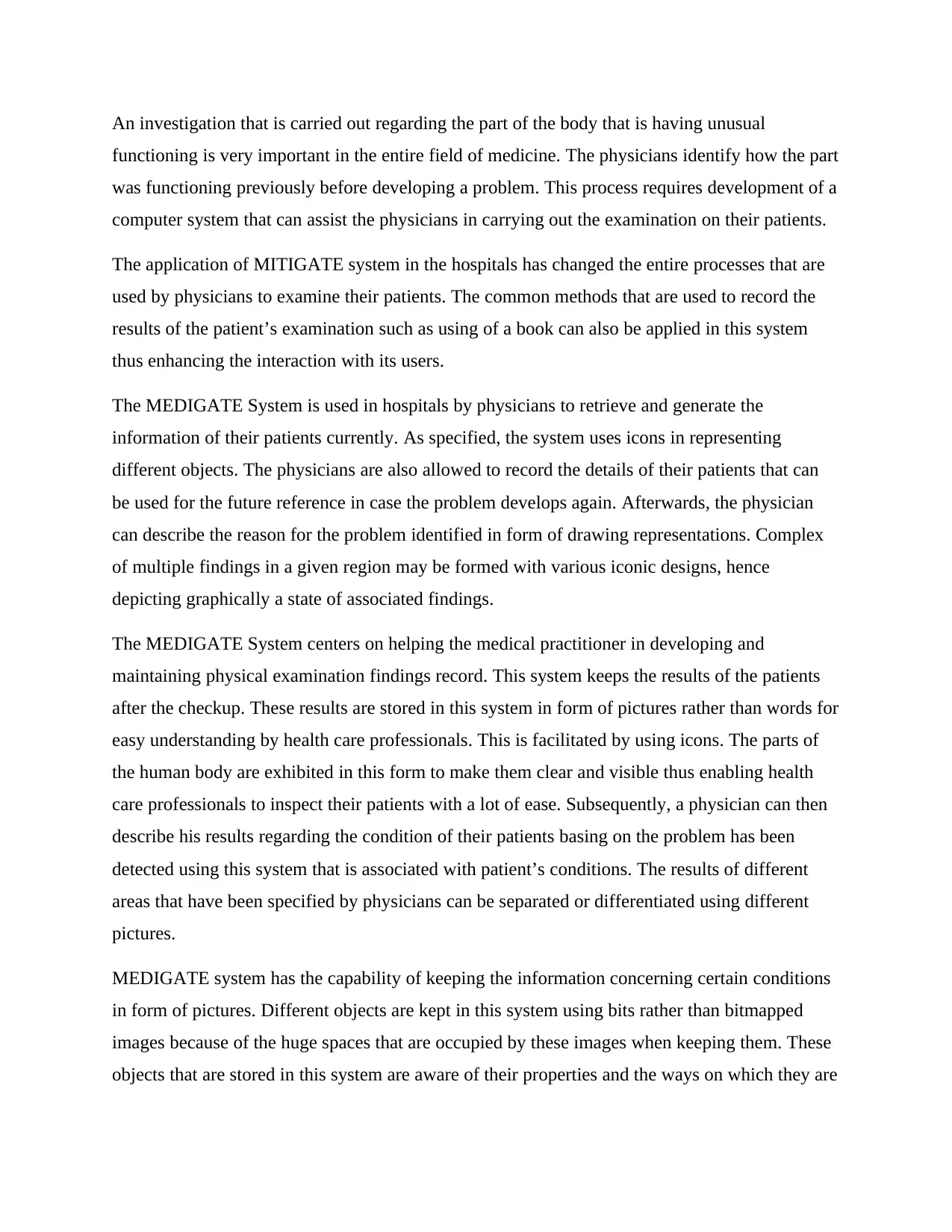
An investigation that is carried out regarding the part of the body that is having unusual
functioning is very important in the entire field of medicine. The physicians identify how the part
was functioning previously before developing a problem. This process requires development of a
computer system that can assist the physicians in carrying out the examination on their patients.
The application of MITIGATE system in the hospitals has changed the entire processes that are
used by physicians to examine their patients. The common methods that are used to record the
results of the patient’s examination such as using of a book can also be applied in this system
thus enhancing the interaction with its users.
The MEDIGATE System is used in hospitals by physicians to retrieve and generate the
information of their patients currently. As specified, the system uses icons in representing
different objects. The physicians are also allowed to record the details of their patients that can
be used for the future reference in case the problem develops again. Afterwards, the physician
can describe the reason for the problem identified in form of drawing representations. Complex
of multiple findings in a given region may be formed with various iconic designs, hence
depicting graphically a state of associated findings.
The MEDIGATE System centers on helping the medical practitioner in developing and
maintaining physical examination findings record. This system keeps the results of the patients
after the checkup. These results are stored in this system in form of pictures rather than words for
easy understanding by health care professionals. This is facilitated by using icons. The parts of
the human body are exhibited in this form to make them clear and visible thus enabling health
care professionals to inspect their patients with a lot of ease. Subsequently, a physician can then
describe his results regarding the condition of their patients basing on the problem has been
detected using this system that is associated with patient’s conditions. The results of different
areas that have been specified by physicians can be separated or differentiated using different
pictures.
MEDIGATE system has the capability of keeping the information concerning certain conditions
in form of pictures. Different objects are kept in this system using bits rather than bitmapped
images because of the huge spaces that are occupied by these images when keeping them. These
objects that are stored in this system are aware of their properties and the ways on which they are
functioning is very important in the entire field of medicine. The physicians identify how the part
was functioning previously before developing a problem. This process requires development of a
computer system that can assist the physicians in carrying out the examination on their patients.
The application of MITIGATE system in the hospitals has changed the entire processes that are
used by physicians to examine their patients. The common methods that are used to record the
results of the patient’s examination such as using of a book can also be applied in this system
thus enhancing the interaction with its users.
The MEDIGATE System is used in hospitals by physicians to retrieve and generate the
information of their patients currently. As specified, the system uses icons in representing
different objects. The physicians are also allowed to record the details of their patients that can
be used for the future reference in case the problem develops again. Afterwards, the physician
can describe the reason for the problem identified in form of drawing representations. Complex
of multiple findings in a given region may be formed with various iconic designs, hence
depicting graphically a state of associated findings.
The MEDIGATE System centers on helping the medical practitioner in developing and
maintaining physical examination findings record. This system keeps the results of the patients
after the checkup. These results are stored in this system in form of pictures rather than words for
easy understanding by health care professionals. This is facilitated by using icons. The parts of
the human body are exhibited in this form to make them clear and visible thus enabling health
care professionals to inspect their patients with a lot of ease. Subsequently, a physician can then
describe his results regarding the condition of their patients basing on the problem has been
detected using this system that is associated with patient’s conditions. The results of different
areas that have been specified by physicians can be separated or differentiated using different
pictures.
MEDIGATE system has the capability of keeping the information concerning certain conditions
in form of pictures. Different objects are kept in this system using bits rather than bitmapped
images because of the huge spaces that are occupied by these images when keeping them. These
objects that are stored in this system are aware of their properties and the ways on which they are
⊘ This is a preview!⊘
Do you want full access?
Subscribe today to unlock all pages.

Trusted by 1+ million students worldwide
1 out of 17
Related Documents
Your All-in-One AI-Powered Toolkit for Academic Success.
+13062052269
info@desklib.com
Available 24*7 on WhatsApp / Email
![[object Object]](/_next/static/media/star-bottom.7253800d.svg)
Unlock your academic potential
Copyright © 2020–2025 A2Z Services. All Rights Reserved. Developed and managed by ZUCOL.





